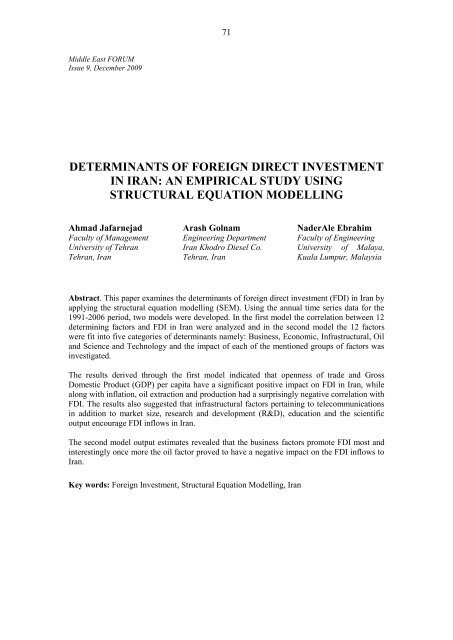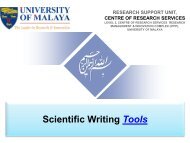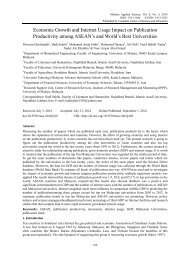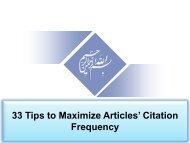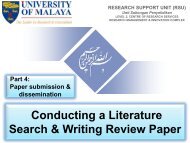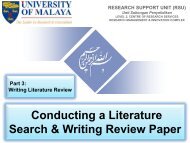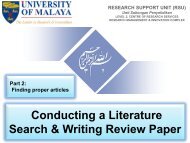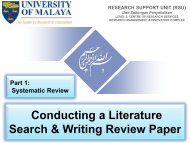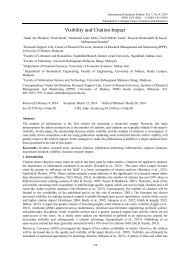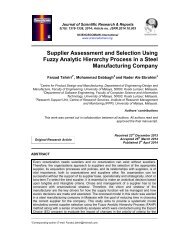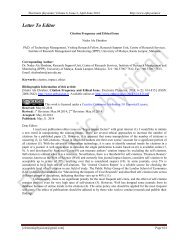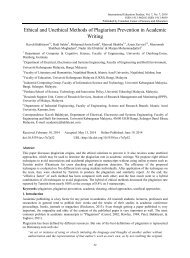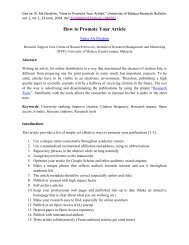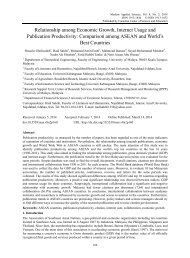DETERMINANTS OF FOREIGN DIRECT INVESTMENT-FORUM 9. Jafarnejad.pdf
You also want an ePaper? Increase the reach of your titles
YUMPU automatically turns print PDFs into web optimized ePapers that Google loves.
71<br />
Middle East <strong>FORUM</strong><br />
Issue 9, December 2009<br />
<strong>DETERMINANTS</strong> <strong>OF</strong> <strong>FOREIGN</strong> <strong>DIRECT</strong> <strong>INVESTMENT</strong><br />
IN IRAN: AN EMPIRICAL STUDY USING<br />
STRUCTURAL EQUATION MODELLING<br />
Ahmad <strong>Jafarnejad</strong><br />
Faculty of Management<br />
University of Tehran<br />
Tehran, Iran<br />
Arash Golnam<br />
Engineering Department<br />
Iran Khodro Diesel Co.<br />
Tehran, Iran<br />
NaderAle Ebrahim<br />
Faculty of Engineering<br />
University of Malaya,<br />
Kuala Lumpur, Malaysia<br />
Abstract. This paper examines the determinants of foreign direct investment (FDI) in Iran by<br />
applying the structural equation modelling (SEM). Using the annual time series data for the<br />
1991-2006 period, two models were developed. In the first model the correlation between 12<br />
determining factors and FDI in Iran were analyzed and in the second model the 12 factors<br />
were fit into five categories of determinants namely: Business, Economic, Infrastructural, Oil<br />
and Science and Technology and the impact of each of the mentioned groups of factors was<br />
investigated.<br />
The results derived through the first model indicated that openness of trade and Gross<br />
Domestic Product (GDP) per capita have a significant positive impact on FDI in Iran, while<br />
along with inflation, oil extraction and production had a surprisingly negative correlation with<br />
FDI. The results also suggested that infrastructural factors pertaining to telecommunications<br />
in addition to market size, research and development (R&D), education and the scientific<br />
output encourage FDI inflows in Iran.<br />
The second model output estimates revealed that the business factors promote FDI most and<br />
interestingly once more the oil factor proved to have a negative impact on the FDI inflows to<br />
Iran.<br />
Key words: Foreign Investment, Structural Equation Modelling, Iran
72<br />
1. INTRODUCTION<br />
Trans-national corporations (TNCs) have become central organizers of economic<br />
activities and major actors in shaping the international division of labour. They<br />
perform this role through foreign direct investment in the host country enterprises.<br />
By most measures TNCs play a larger role in the world economy today than they did<br />
in the past in terms and in relation to key economic indicators such as gross domestic<br />
product (GDP), exports and domestic capital formation in the world economy as a<br />
whole and in the host countries both developed and developing (UNCTAD 1992).<br />
FDI inflows can lead to a range of economic benefits for transitional and developing<br />
countries, including restructuring their economic activities in line with dynamic<br />
comparative advantage; reducing their costs of structural adjustment; raising the<br />
productivity of national resources and capabilities; improving quality standards and<br />
finally stimulating economic growth (Dunning 1994), (Jones, Fallon et al. 2000).<br />
Various international organizations and foreign advisors recommend developing<br />
countries to rely primarily on foreign direct investment (FDI) as a source of external<br />
finance. They argue that, for several reasons, FDI stimulates economic growth more<br />
than other types of capital inflows. In particular, FDI is supposed to be less volatile,<br />
and to offer not just capital but also access to modern technology and know-how.<br />
However, it is surprisingly hard to support by empirical evidence this policy advice.<br />
Some studies find a positive relationship between FDI inflows and economic growth<br />
in host economies. (Caves 1996)<br />
It is also widely accepted that FDI can have direct positive potential impact on host<br />
economies including the creation of well paid employment for scientists and<br />
engineers; better use of locally available materials; technology transfer (new<br />
equipment, laboratories, etc.); and the design of consumer products better suited to<br />
domestic needs, the development of new disciplines and specializations at local<br />
universities; the development of R&D clusters; and spin-offs of by-products that<br />
TNCs do not want to develop themselves.(UNCTAD 2005)
73<br />
With around 1% of the population of the world, Iran currently possesses 7% of the<br />
world’s natural reserves including 10% of the global proven oil reserves, 16% of the<br />
world’s natural gas resources and has the largest natural gas resources worldwide after<br />
Russia.(BMI 2008)<br />
The availability of these energy reserves and an abundance of natural resources<br />
provide an obvious locational advantage with respect to attracting FDI given the<br />
increasing importance of energy and other materials in the expanding global market.<br />
It offers prospects for lower costs for production facilities in Iran but also suggests a<br />
future concentration of R&D capability associated with these industries.<br />
From the perspectives of the economies of scale involved in the activities of TNCs,<br />
many studies conclude that the size of the host country market measured by GDP or<br />
real GDP can put significantly positive influence on the flows of FDI into a region, in<br />
other words the bigger the market of an economy, the more FDI the region can<br />
attract.(Dunning 1993; Holland and Sass 2000; Durán and Ubeda 2001; Globerman<br />
and Shapiro 2002; Sun, Tong et al. 2002; Zhou and Lall 2005; Ang 2008)<br />
Unlike most middle eastern countries such as UAE, Kuwait, Bahrain, Saudi Arabia<br />
and Turkey that will have negative or slight GDP per capita growth, Iran will have<br />
over 150% growth in the GDP per capita by 2012 (BMI 2008) considering the<br />
population growth of 1.5% (WB).<br />
Keeping the above mentioned factors in mind, an expectation of growth in FDI<br />
inflows to Iran is realistic, however with the 901 M$ of inward FDI flow in 2006, the<br />
Islamic Republic of Iran stands at the 133rd position out of 141 economies<br />
(UNCTAD 2007). The relatively small scale of FDI inflows into Iran is also reflected<br />
in the two following diagrams.
74<br />
2. RESEARCH METHODOLOGY<br />
Most of the previous studies of the determinants of FDI inflows have been based<br />
on a regression in the form of the following equation;<br />
Equation 1<br />
where FDI i is inward foreign direct investment flows into country i and xji the jth<br />
explanatory variable of country i. These studies report a sample of regressions,<br />
including a certain set of explanatory variables. The problem is that theory<br />
(particularly the theory of FDI) is not adequately explicit about the variables that<br />
should appear in the “true” model. The following problem is often encountered: x1<br />
may be significant when the regression includes x2 and x3, but not when x4 is<br />
included. So, which combination of all available xj’s do we choose? Most, if not all,<br />
of the existing studies report the most “appealing” or convenient regression or<br />
regressions after extensive search and data mining, typically to confirm a<br />
preconceived idea (Moosa and Cardak 2006).<br />
In order to build up the model and test the impact of the determining variables on FDI<br />
the structural equations modeling (SEM) as developed by Jöreskog (Jöreskog 1970),<br />
and extended by Goldberger & Duncan (Goldberger and Duncan 1973) was applied.<br />
SEM is a powerful technique that can combine complex path or simultaneous<br />
equation model and it includes confirmatory factor analysis and regression models.
75<br />
The particular advantage of SEM is involving latent variables and as a result<br />
investigating causal theories as they pertain directly to the underlying constructs of<br />
interest, rather than to the measured variables whose observed relations are often<br />
attenuated by error of measurement.<br />
Many researchers consider SEM to be a second generation statistical tool following<br />
multiple regression, factor analysis, and path analysis. Goldberger (Goldberger 1973)<br />
outlined three situations in which multiple regression falls short of structural<br />
equations: when the observed variables contain measurement errors and the<br />
interesting relationship is among the true variables; when there is interdependence or<br />
simultaneous causation among the observed response variables, and when important<br />
explanatory variables have not been included in the analysis.<br />
As another advantage SEM enables researchers to answer a set of interrelated research<br />
questions by modeling the relationships among multiple independent and dependent<br />
constructs simultaneously. This capability for simultaneous analysis differs greatly<br />
from most first generation regression models which can analyze only one layer of<br />
linkages between independent and dependent variables at a time. Hence instead of<br />
testing the hypothesized relationships one by one, by applying SEM all the<br />
relationships among the model are tested simultaneously (Bollen 1989).<br />
In addition, by applying SEM measurement error in the process of model building can<br />
be identified, estimated and then removed and by estimating and removing<br />
measurement error, the reliability of multiple indicators can be explicitly calculated<br />
within the analysis and more importantly the intricate causal networks enabled by<br />
SEM characterize real-world processes better than simple correlation-based models.<br />
Therefore, SEM is more suited for the mathematical modeling of complex processes<br />
to serve both theory and practice (Dubin 1976), (Gefen, Straub et al. 2000).<br />
3. RESEARCH VARIABLES<br />
Different sets of variables have been defined in the various studies conducted on<br />
determinants of FDI such as (Ang 2008), (Asiedu 2002), (Bevan and Estrin 2004),
76<br />
(UNCTAD 1998), (Altomonte 2000), (Driffield and Noor 1999), (Ford and Strange<br />
1999), (Holland and Sass 2000),(Nunnenkamp and Spatz 2002), (Zhou and Lall<br />
2005), (Moosa and Cardak 2006), (Mina 2007), (Na and Lightfoot 2006), (Sun, Tong<br />
et al. 2002).<br />
After an in-depth and a state of the art review of the existing literature while<br />
considering the availability of data and practicality of data collection in mind, the<br />
following variables were defined and calculated for Iran in the period between1991-<br />
2006. Table 1 and Table 2 summarize the variables, their indicators and the source of<br />
data.<br />
Determining Latent Independent Observed (exogenous) Indicators Data Source<br />
Factors<br />
Variables<br />
Market Size GDP (Million USD) (WB)<br />
Economic Purchasing Power GDP Per Capita (WB)<br />
Economic Risk Inflation Rate (IMF)<br />
Infrastructure Telecommunications Fixed Line and Mobile Phone Subscribers per 1000 (WB)<br />
People<br />
Business Trade Openness (Import + Export)/GDP (WB)<br />
Oil Exploitation Crude Oil Production (1000 barrels per day) (OPEC)<br />
Oil<br />
Oil Potential Proven Crude Oil Reserves (Million Barrels) (OPEC)<br />
Relative Oil Exploitation Crude Oil Production/Reserves (OPEC)<br />
Science and Innovation Total Patent Applications Filed (UNESCO)<br />
Technology R&D Expenditure on R&D as a Percentage of GDP (UNESCO)<br />
Education Total Enrollments in All Tertiary Programs/ Population (UNESCO)<br />
Scientific Out put Journal Paper Publications (NRISP)<br />
Table 1-The Latent independent variables and their observed indicators<br />
Latent Dependant Variable Observed (endogenous) Indicator Data Source<br />
Inward FDI In Iran Inward FDI (Million USD) (UNCTAD 2007)<br />
Table 2- The latent dependant variable and its observed indicator<br />
4. MODEL DEVELOPMENT<br />
On the basis of the data gathered two models were developed and tested, in Model<br />
1 the impact of each individual factor on the FDI inflows to Iran was analyzed in<br />
order to get a micro view about the individual factors determining the FDI inflows<br />
and their level of significance. In model 2, all the independent variables were<br />
classified into five different categories as shown in Table 1and the impact of each<br />
category on the dependent variable (i.e. inward FDI) was investigated.
77<br />
Both models were developed on the basis of General Model of Structural Equation<br />
Modelling. Figure 3 shows a general model of SEM, where, η (eta) represents the<br />
latent dependent, or endogenous, variables; ξ (ksi) represents latent independent, or<br />
exogenous, variables; Y represents the observed (endogenous) indicators of the<br />
dependent latent var<br />
the independent latent variables; ε (epsilon) is a p x 1 measurement errors in an<br />
observed endogenous variable y; (delta) is a q x 1 vector of measurement errors in<br />
an observed exogenous variable x; λ(y) (lamda y) represents coefficients of the<br />
(X) (lamda x) represent the coefficients of the regression of<br />
ξ.<br />
a. Model 1<br />
Figure 4 illustrates model 1 w here X1-X1 2 are the observed indicators for<br />
the latent independent variables of ξ −ξ 2 as explained in Table 1. For instance ξ 3<br />
represents economic risk which as a latent independent variable for which inflation<br />
(X 3 ) is the obseved indicato r. η represents the latent dependent variable of inward F<br />
DI to Iran which has been indicated by the observed variable of Y that represent<br />
Inward FDI (Million USD).<br />
b. Model 2<br />
As shown in Figure 5, in Model 2, the determining factors of Inward FDI as listed in<br />
Table 1; namely economic, infrastructure, business, oil and science and technology<br />
have been considered as the latent independent variables and respectively represented<br />
by ξ − ξ 5 , while their observed indicators X 1 -X 12 and the latent dependent variable<br />
and its indicator are similar to Model 1.<br />
5. RESULTS<br />
The models were developed by means path diagram of LISREL 8.53 software 1 , and<br />
afterwards the covariance matrices of the gathered data were calculated and the<br />
model was r un. Table 3 and Table 4 report t he path coefficients high lighting the
78<br />
correlation between the latent variables and the pertinent T Values in Model 1 a nd<br />
Model 2 respectively.<br />
LISREL provides several indications of the extent to which the sampled data fits the<br />
researcher-specified model. In the case of model 1 and 2 the fit indices, as<br />
summarized in Table 5, indicate that the models are reasonably good-fitting models<br />
based on the acceptable range of fit indices in LISREL as discussed extensively by<br />
Bentler (Bentler 1990) and Hoetler (Hoetler 1983) .<br />
1 - Root Mean Square Error for Approximation<br />
2 - Comparative Fit Index<br />
3 - Normed Fit Index<br />
4 - Goodness of Fit Index<br />
5 - Adjusted Goodness of Fit Index
79<br />
6. CONCLUSION AND POLICY IMPLICATIONS<br />
Trade openness contributes significantly positively to FDI inflows in Iran; hence<br />
policy improvements with respect to business ease and trade liberalization will<br />
undoubtedly result in higher FDI inflows. Therefore it can be implied that more FDIfriendly<br />
regulatory improvements shall be implemented with the purpose of trade<br />
facilitation and business ease if Iran is to adopt a welcoming stance to FDI inflows.<br />
Based on the empirical results, market factors promote FDI inflows to Iran<br />
significantly. It was also observed that economic risk indicated by inflation serves as<br />
an obstacle to FDI inflows with a substantially negative correlation coefficient. In<br />
other words investors are attracted to growth in Iran’s GDP and GDP per capita and<br />
react negatively towards any increase in Iran’s inflation.<br />
The empirical evidence also points to the importance of infrastructure base in<br />
particular telecommunications infrastructure. Therefore the availability of fixed and<br />
mobile phone lines besides broad band internet connection promote Iran as a<br />
prospective investment location.<br />
As might have been expected, research and development along with other S&T<br />
indicators promote FDI to a relatively high degree although their impact is not as<br />
high as business and economic factors. This can serve to highlight the fact that FDI<br />
in Iran has been more of a resource and market seeking types than an efficiency<br />
seeking which can be interpreted as a threat by the emergence of knowledge and<br />
innovation as the key competitive advantages in global business environment.<br />
Hence developing a national culture supportive of invention, risk-taking,<br />
entrepreneurship and research in addition to orienting the support budget to R&D in<br />
an enterprise scale can definitely serve to enhance the overall S&T perspective of<br />
Iran. It is also recommended that a new and less bureaucratic approach to R&D<br />
support is established so that a systematic and continuous approach to R&D within<br />
enterprises is encouraged.
80<br />
Surprisingly oil exploitation and oil potential were proven to impact FDI in flows<br />
negatively while the analysis suggest that increase in relative oil production leads to<br />
more FDI inflows. The findings of this research pertaining to the impact of oil factors<br />
on FDI inflows can be subject to a new research in order to track the dynamic impact<br />
of oil on Iran’s economy and Iran’s perceived attractiveness as a location for foreign<br />
investment.<br />
It should also be noted that due to unavailability of empirical data, political factors<br />
such as Iran’s political stability and the influence of the sanctions were not<br />
incorporated within the research framework. Since the impact of such political issues<br />
is considerably significant in the macroeconomic perspective of a country and the<br />
perceived investment risk, further research needs to be carried to clarify the extend to<br />
which political factors can influence FDI inflows in Iran.<br />
References<br />
Altomonte, C. (2000). "Economic determinants and institutional frameworks: FDI in<br />
economies in transition." Transnational Corporations 9(2): 75-106.<br />
Ang, J. B. (2008). "Determinants of foreign direct investment in Malaysia." Journal of<br />
Policy Modeling 30: 185-18<strong>9.</strong><br />
Asiedu, E. (2002). "On the determinants of foreign direct investment to developing<br />
countries, is Africa different?" World Development 30(1): 107-11<strong>9.</strong><br />
Bentler, P. M. (1990). "Comparative fit indexes in structural models." Psychometrika<br />
107: 238-246. Bevan, A. A. and S. Estrin (2004). "The determinants of foreign direct<br />
investment into European transition economies." Journal of Comparative<br />
Economics(32): 775–787.<br />
BMI (2008). Iran Business Environment SWOT Business Monitor International.
81<br />
Bollen, K. A. (1989). Structural Equations with Latent Variables. New York, John<br />
Wiley and Sons.<br />
Caves, R. (1996). Multinational Enterprise and Economic Analysis, Cambridge and<br />
New York: Cambridge University Press.<br />
Driffield, N. and A. H. M. Noor (1999). "Foreign direct investment and local input<br />
linkages in Malaysia." Transnational Corporations 8(3).<br />
Dubin, R. (1976). Theory Building in Applied Areas. Handbook of Industrial and<br />
Organizational Psychology. Chicago, Rand McNally College Publishing Co.: 17-26.<br />
Dunning, J. H. (1993). Multinational Enterprises and the Global Economy. New<br />
York: , Addison-Wesley. Dunning, J. H. (1994). "Re-evaluating the benefits of<br />
foreign direct investment." Transnational Corporations 3(1): 27-51.<br />
Durán, J. J. and F. Ubeda (2001). "The investment development path: a new empirical<br />
approach and some theoretical issues." Transnational Corporations 10(2).<br />
Ford, S. and R. Strange (1999). "Where do Japanese manufacturing firms invest<br />
within Europe, and why?" Transnational Corporations 8(1): 117-142.<br />
Gefen, D., D. W. Straub, et al. (2000) . "Structural Equation Modelling and<br />
Regression: Guidlines for Research Practice." Association for the Information<br />
Systems 4.<br />
Globerman, S. and D. Shapiro (2002). "Global foreign direct investment flows: the<br />
role of governance infrastructure." World Development 30(11).<br />
Goldberger and O. D. Duncan (1973). Structural EquationsModels in the Social<br />
Sciences. New York, Academic Press.<br />
Goldberger, A. S. (1973). Structural equation models: An overview. New York,
82<br />
Seminar Press.<br />
Hoetler, J. W. (1983). "The analysis of covariance structures: Goodness-of-fit<br />
indices." Sociological Methods and Research 11: 325-344.<br />
Holland, D. and M. Sass (2000). "The determinants and impact of FDI in Central and<br />
Eastern Europe: a comparison of survey and econometric evidence." Transnational<br />
Corporations 9(3).<br />
IMF. "International Monetary Fund, Online Statistics Center." Retrieved September,<br />
2008, from http://www.IMF.org.<br />
Jones, A., G. Fallon, et al. (2000). "Obstacles to foreign direct investment in Russia."<br />
European Business Review 12(4): 187-197.<br />
Jöreskog, K. G. (1970). "A general method for analysis of covariance structures."<br />
Biometrika 57: 239-251. Mina, W. (2007). "The location determinants of FDI in the<br />
GCC countries." Journal of Multinational Financial Management 17: 336-348.<br />
Moosa, I. A. and B. A. Cardak (2006). "The determinants of foreign direct<br />
investment: An extreme bounds analysis." Journal of Multinational Financial<br />
Management 16: 199-211.<br />
Na, L. and W. S. Lightfoot (2006). "Determinants of foreign direct investment at the<br />
regional level in China." Journal of Technology Management in China 1(3): 262-278.<br />
NRISP. "National Research Institute for Science Policy/ Scientific Out put Statistics."<br />
Retrieved August, 2008, from http://www.nrisp.ir.<br />
Nunnenkamp, P. and J. Spatz (2002). "Determinants of FDI in developing countries:<br />
has globalization changed the rules of the game?" Transnational Corporations 11(2).<br />
OPEC. "Organization for Petroleum Exporting Countries/Online Statistics Center."<br />
Retrieved August, 2008, from http://www.opec.org.
83<br />
Sun, Q., W. Tong, et al. (2002). "Determinants of foreign direct investment across<br />
China." Journal of International Money and Finance 21: 79-113.<br />
UNCTAD (1992). "World Investment Report: Transnational Corporations as<br />
Engines of Growth." UNCTAD (1998). "World Investment Report: Trends and<br />
Determinants".<br />
UNCTAD (2005). "Report of the Expert meeting on the Impact of FDI on<br />
Development." United Nations Conference on Trade and Development.<br />
UNCTAD (2007). "World Investment Report 2007:Transnational Corporations,<br />
Extractive Industries and Development."<br />
UNESCO. "United Nations Education and Science Cooperation/ Annual Report<br />
2007." Retrieved August, 2008, from http://www.unesco.org.<br />
WB. "World Bank / World development indicators 2007." Retrieved August, 2008,<br />
from (http://www.worldbank.org/data).<br />
Zhou, Y. and S. Lall (2005). "The impact of China’s FDI surge on FDI in South-East<br />
Asia: panel data analysis for 1986-2001." Transnational Corporations 14(1).


